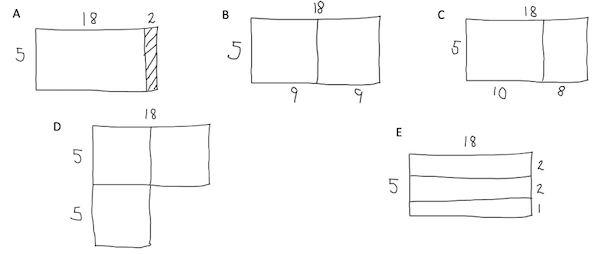Or search by topic
Number and algebra
Geometry and measure
Probability and statistics
Working mathematically
Advanced mathematics
For younger learners
Picture Your Method



For the first part of this task, you're going to try to answer a calculation in your head, without using pencil or paper. When you're ready, click below to see the calculation.
What is 18 x 5?
Jot down your answer.
The answer is definitely not the most interesting part of this problem! Much more interesting is thinking about the way you arrived at your answer.
Below you can read what five learners said when they were asked how they worked out their answer:
Bryan:
First I doubled 18 to get 36.
Then I doubled that to get 72.
Then I added 18 again.
Neil:
I took 18 and I halved that, which is 9.
9x5 is 45, 9x5 is 45.
Then I added 45 and 45 together.
Sammi:
I separated 18 into 8 and 10.
8x5 is 40. 10x5 is 50.
I then added 40 and 50 together.
Ricardo:
I did 9x10 instead of 18x5 because that's the same thing.
Jaime:
I did 20x5, which is 100.
Then I took away 2x5, which is 10.
Was your method the same as any of these? If not, describe what you did.
We can also draw each of these ways of working out 18x5. (We might say we can represent each one visually.)
Can you match each drawing below to one of the methods described above? (We've labelled each of the drawings with a letter to make it easier to refer to a particular one.)

You may like to print off this sheet which contains all five descriptions and all five drawings, and which could be cut up into ten cards.
How did you decide on the pairings?
If you used a different method, create a drawing of your method too.
This task is inspired by a YouCubed resource and is used with permission.
You may also like
Exploring Wild & Wonderful Number Patterns
EWWNP means Exploring Wild and Wonderful Number Patterns Created by Yourself! Investigate what happens if we create number patterns using some simple rules.
Sending Cards
This challenge asks you to investigate the total number of cards that would be sent if four children send one to all three others. How many would be sent if there were five children? Six?
Dice and Spinner Numbers
If you had any number of ordinary dice, what are the possible ways of making their totals 6? What would the product of the dice be each time?

